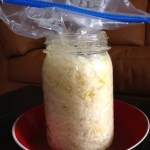By Joyce
Chop. Chop. Time to harvest and preserve the kohlrabi. I had a hunch kohlrabi would make a good ferment because as a brassica it is sweet, similar in color, and crunchy like cabbage, but this outer-worldly looking vegetable is even more versatile. In this ferment, I added Hungarian hot wax peppers to give subtle spice, and indeed, the combo created a delicate balance of flavors.
Below is my recipe, such as it is. The fermentation process lends itself to experimentation and variation. I change it up based on what is available from my garden or on sale in the grocery store, usually making just quart size containers at a time. Having a few different ferments bubbling away on the kitchen counter or in the refrigerator allows me to serve several small side dishes (Korean-style) alongside main dishes at dinner. The variation at the table not only stimulates interest but the digestion as well.
 In Vegetable Fermentation Further Simplified, Sandor Katz gives the lowdown on how to ferment any vegetable. If you are looking to get into fermentation, follow his guidelines and you’ll be making very original side dishes and manufacturing your own tasty probiotics in your kitchen in no time. I’d love to hear about what you are fermenting.
In Vegetable Fermentation Further Simplified, Sandor Katz gives the lowdown on how to ferment any vegetable. If you are looking to get into fermentation, follow his guidelines and you’ll be making very original side dishes and manufacturing your own tasty probiotics in your kitchen in no time. I’d love to hear about what you are fermenting.
Fermented Kohlrabi
3 – 4 kohlrabi
2 Hungarian hot wax peppers
2 teaspoons salt
Peel skin off kohlrabi and shred in cuisine art or mandolin.
Place shredded kohlrabi in bowl and sprinkle 2 teaspoons of salt over kohlrabi.
Wash hands and massage kohlrabi until you’ve squeezed out as much liquid as possible.
Mix in diced hot wax peppers
Pack vegetables into a canning jar.
Pour liquid over the top of vegetables.
Fill plastic baggie with enough water to weigh down kohlrabi so it is submerged under liquid (usually just 1/2 cup of water).
Place on kitchen counter in a bowl. As it ferments it will bubble up and excess will spill into bowl.
Wait 3 – 7 days, or more. Taste often until flavor appeals to you.
Cover with a lid and place in refrigerator.
Read more here: DailySelfCure
September 18, 2013
Fermented Kohlrabi
Joyce Uncategorized
By Joyce
Chop. Chop. Time to harvest and preserve the kohlrabi. I had a hunch kohlrabi would make a good ferment because as a brassica it is sweet, similar in color, and crunchy like cabbage, but this outer-worldly looking vegetable is even more versatile. In this ferment, I added Hungarian hot wax peppers to give subtle spice, and indeed, the combo created a delicate balance of flavors.
Below is my recipe, such as it is. The fermentation process lends itself to experimentation and variation. I change it up based on what is available from my garden or on sale in the grocery store, usually making just quart size containers at a time. Having a few different ferments bubbling away on the kitchen counter or in the refrigerator allows me to serve several small side dishes (Korean-style) alongside main dishes at dinner. The variation at the table not only stimulates interest but the digestion as well.
Fermented Kohlrabi
3 – 4 kohlrabi
2 Hungarian hot wax peppers
2 teaspoons salt
Peel skin off kohlrabi and shred in cuisine art or mandolin.
Place shredded kohlrabi in bowl and sprinkle 2 teaspoons of salt over kohlrabi.
Wash hands and massage kohlrabi until you’ve squeezed out as much liquid as possible.
Mix in diced hot wax peppers
Pack vegetables into a canning jar.
Pour liquid over the top of vegetables.
Fill plastic baggie with enough water to weigh down kohlrabi so it is submerged under liquid (usually just 1/2 cup of water).
Place on kitchen counter in a bowl. As it ferments it will bubble up and excess will spill into bowl.
Wait 3 – 7 days, or more. Taste often until flavor appeals to you.
Cover with a lid and place in refrigerator.
Read more here: DailySelfCure
Share this: